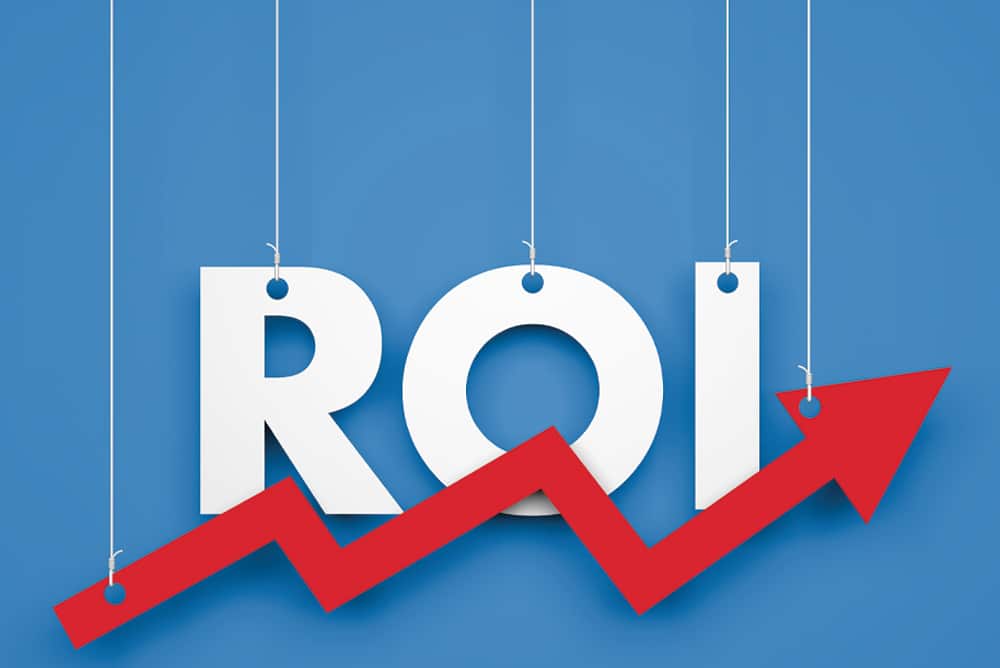How to Calculate ROI for SEO
You must know how to calculate SEO ROI if you want to remain results driven. “The ROI of social media is that your business will still exist in 5 years.”Erik Qualman, author of Socialnomics: How Social Media Transforms the Way We Live and Do Business Cruisy as it would be to just trot out the…
Written by Angela
Last updated February 27, 2025 • First published February 25, 2020

You must know how to calculate SEO ROI if you want to remain results driven.
“The ROI of social media is that your business will still exist in 5 years.”
Erik Qualman, author of Socialnomics: How Social Media Transforms the Way We Live and Do Business
Cruisy as it would be to just trot out the above quote to our clients as a rationale for investing in savvy, expert SEO, as a business ourselves we fully understand the importance of knowing there will be a return on our investment. As a business owner you’d be mad to just throw money at things willy nilly, without some measurement practices and protocols in place.
When it comes to SEO, however, calculating SEO ROI and proving the value of an optimization campaign can be tricky.
Fortunately, we thrive on tricky – we work in the world of Google, after all, where ever-changing algorithms and SEO trickery are the order of the day! This is why we’ve put together this blog on the basics of how to calculate SEO ROI to confirm your efforts are working.
What does ROI mean for SEO?
Return on Investment (ROI), specifically in relation to SEO, is a black and white metric that is used to judge the success of an SEO strategy. ROI is based on the estimated return of the initial cost to set up SEO for your business and push it out live online. In other words, it’s a tallying of the cold hard cash that you’re putting back into your pocket courtesy of the SEO implemented on your website.
Why is calculating SEO ROI considered tricky?
When it comes to estimating the performance of your SEO, you can definitely look at search volume and organic traffic as indicators of whether or not your SEO campaigns are performing well. But you’re not here for that, are you?
LIKE WHAT YOU’RE READING?
If these articles are helpful,
imagine what our team
can do for you!


More Traffic. Leads. Business.
I want to show you how SEO can grow your business in ways you haven’t seen before.
More Traffic. Leads. Growth.

I want to show you how SEO can grow your business in ways you haven’t seen before.
You’re reading this article because you want to know how much money you made back after spending money on SEO. Money does make the world go round, no matter how unmaterialistic you may be or how philanthropic your business is! When all is said and done, in the world of business, it’s revenue that is the true measure of success.
E-commerce Websites
For ecommerce websites, calculating said revenue is fairly simple. If you have the correct e-commerce tracking in place calculating ROI is as simple as calculating the percentage increase in revenue using a formula like this:
SEO ROI = (SEO Revenue -SEO Cost) / SEO Cost
Non E-commerce Websites
For non e-commerce sites, or lead-based businesses (such as the bulk of our clients), how to calculate SEO ROI can seem slightly more esoteric, intangible even. Given that good, long-lasting SEO can take time to kick in with long-lead times and no insta-results, it involves front-weighted investments. It also demands patience as SEOs continue to encounter suspicion and doubt around the potential value of SEO.
Unless of course, you know what you’re doing and know how to prove its value with solid statistical evidence. Which we do.
It’s definitely easier to track conversions, and hence calculate ROI, for e-commerce businesses. The numbers are an obvious indication of value and numbers don’t lie. Rest assured, though, that there is a way to calculate SEO ROi for non e-commerce sites too. Like all things SEO, however, it just involves a bit of work up front to reap the rewards. For the purposes of this article, we will focus on how to calculate SEO ROI for these, trickier, lead-based, non e-commerce businesses.
Guideline On How to calculate SEO ROI
In its simplest form, the goal of your SEO campaign(s) is to improve your ranking in search engines. The rationale being that: higher ranking leads to higher traffic; higher traffic leads to more conversions; more conversions leads to increased revenue.
Again, it would be quite the cruisy way out to tell our clients that they can measure the success of their SEO investment by looking at just those key indicators:
- Improved ranking on SERPs
- Increase in traffic to their website
We’re not ones to take the cruisy way out though. (Why on earth would we have made SEO our business then?! #justsaying.) Instead, we help our clients set up conversion tracking and measurable parameters within their sites’ analytics tools to help them see the true, numerical, statistical value of their SEO investment. For it is within conversion tracking that the key to calculating ROI on SEO for lead-based businesses lies.
If this is you, you need to:
- Set goals (or conversions);
- Assign monetary values to those goals or types of conversions; and
- Track and analyze conversions.
- Once all of these are in place, you will be able to accurately calculate your ROI on SEO.
Using Google Analytics as our reference or as an example of how to do just this, here are some key pointers in setting up conversion tracking for ROI calculation purposes.
Prep Work: Keyword Segmentation
Before you begin with Steps 1 through 4 below, an important note:
At this stage you need to make sure you exclude your own branded keywords from analysis to give you a clean shot at calculating ‘unbiased’ ROI.
What do we mean by this?
Some users may already know your company or brand by name, but not your website, and will thus search for you online using your name rather than going directly to your website (by typing in your URL). Full disclosure: much as we’d like to claim all and any searches relating to our clients, credit for any searches done like this, by brand name, cannot be given to SEO. Which is why (sob) they need to be excluded. (See how here. You can also learn more about generic and branded keywords here.)
Now you’re ready to start tracking your conversions and the ROI on your SEO efforts.
1. Setting goals/conversions
Depending on your type of business, a conversion might be:
- A newsletter sign-up,
- An email opt-in,
- A live-streaming workshop registration,
- An online form completion requesting more info,
- Or something as simple as page views.
All of these actions taken by visitors to your website are considered your company’s ‘goals’ and should be added as such into the goals section in Google Analytics (Admin → View → Goals).
2. Assigning monetary values to goals/conversions
Now that you’ve got your goals set up, you need to assign an estimated monetary value to each of them. A form requesting more information might be worth $50 to you, for example. Or an email opt-in might be worth $100.
But how do you determine that numerical value? How do you know how much each of your conversions is worth in actual dollar amounts?
To determine how many of the leads or goals you’ve set up convert into conversions (i.e., transactions that ultimately put money in your pocket), and the value for each of those leads, WebFX uses the following formula (and it’s certainly one of the easier ways to calculate value we’ve come across):
Step 1: Determine how many of the leads convert into sales. Say you get 100 customers completing ‘more information forms’ per month; 25 of those form-fillers, a.k.a., leads, become customers; that means that that specific goal (form completion) has a 25% conversion rate.
Step 2: Determine the average value of each sale. If each of those leads that convert – or became customers – spends $100, your average value is $100.
Step 3: Determine the value of each lead. Divide the total value of conversions by your original number of leads. Using the values in the example here, if you earn 25 customers and they each spend $100, you make $2,500. Divide that $2,500 by your original 100 leads, and each lead from this goal is worth $25 on average.
Follow this formula for each of your goals, then enter the dollar value into the ‘goal details’ (Admin → View → Goals → Goal Details) section in Google Analytics so that you have some concrete numbers to work with in order to calculate ROI.
3. Track and analyze your conversions
Round about now is when that patience needs to kick in! (We’ve said it once, we’ll say it again: good SEO, the kind that yields long-term results, needs patience. It’s a virtue. Practice it.) Give your site, your site visitors, and your site analytics a month or two to do their thing, hence giving you some concrete data to do your ROI thing.
After your patience has run out, you can then run a conversions report through Google Analytics. From this, you’ll receive data on all your website traffic, and from this you will be able to see how many of your conversions, or those goals you set up earlier, were met thanks to paid search, organic search, emails, referrals, social media, and so on and so forth.
You’re going to want to pay particular attention to ‘organic traffic’ as any conversions met through this channel are conversions you can attribute to your SEO efforts. (Remember when we told you to exclude your branded terms from your analytics? Here’s where the importance of that kicks in.)
By comparing the value assigned to organic traffic for your conversions with the amount of money you’ve spent on SEO during the same time period, and you can start to see some actual numerical value to your SEO and get an idea of your ROI. So, for example, if your revenue from organic traffic is $20,000 in one month, and you paid an SEO company $2,000 to implement keyword research and other SEO tactics (content or otherwise) on your site, then your ROI is $18,000.
4. Calculate your ROI percentage
Now it’s time to do the math. Crunch the numbers. Feel good about your savvy decision to invest in SEO and make sure your company will still be around in 5 years.
To calculate your ROI percentage, use this formula:
(Gain from Investment – Cost of Investment) / Cost of Investment
Then, multiply the resulting number by 100 to get your ROI percentage value.
So, using the example numbers above:
→ 20,000 – 2,000 / 2,000
→ 18,000 / 2,000 = 9
→ 9 x 100 = 900
Your ROI is 900%
Easy right? Lol.. just kidding. Look, we know that all of this might be making your head spin. SEO in general tends to do that to people. And then we went and added in math! Mind. Blown. The bottom line is this: there is exceptional value in SEO. But it has to be SEO done right. And whoever does your SEO for you must be able to prove it – in numerical, cash value terms. Make sure they do.
Keen to invest in SEO and reap the ROI rewards?
It’s great to know how to calculate SEO ROI but has to be something worth taking to the bank. For that, you need a top-notch SEO company! 1st on the List can give you just that and help you make the most of your investment.
Our SEO professionals are ready to take your call on 1-877-563-0459 or email [email protected].
FAQs ABOUT ROI ON SEO
1. What is the ROI of SEO?
Return on Investment (ROI) of SEO is a metric used to judge the success of an SEO strategy based on the estimated return of the initial cost to set up SEO for your business online. In other words, it’s a numerical tally of the cold, hard cash you’re putting back into your pocket thanks to the SEO implemented on your website.
2. How do you calculate ROI for SEO?
The formula for calculating ROI on your SEO efforts is fairly basic: (Gain from Investment – Cost of Investment) / Cost of Investment. However, to get to the point where you can use this formula you do need to set up some goal setting for conversion tracking within your analytics tool.
3. Is implementing SEO profitable?
When implemented properly, SEO will improve your ranking in search engines. This will, in time, prove profitable for your business using the following rationale: higher ranking leads to higher traffic; higher traffic leads to more conversions; more conversions leads to increased revenue.
4. How do you measure SEO results?
To measure the results of your SEO efforts you should track metrics like:
Conversion rate (which involves setting goals in your analytics tool)
Number of pages per visit
Time on page
Bounce rate
Backlinks
Organic traffic
Click through rate
Mobile traffic
ROI (calculated using conversions/goals)
Angela
Angela Tucker has maintained the role of Lead Technical Optimizer at 1st on the List since our company was founded in 1997. She has experienced every one of Google’s algorithm updates and has the ability to review a website on a micro-level to pinpoint all the areas that could potentially be causing ranking issues. Her specific areas of expertise include Site Speed Optimization, Knowledge Graph, and Schema Markup.
Don’t miss out – get newest posts straight to your inbox!
OTHER ARTICLES WE THINK YOU’LL ENJOY
Partner With Us. Get More Leads.
Stop trying to do it all on your own – reach out to our team and we can discuss marketing strategies that are best suited for your business!
[NO HASSLE, NO PRESSURE, NO WORRIES – JUST MEANINGFUL INSIGHTS]








